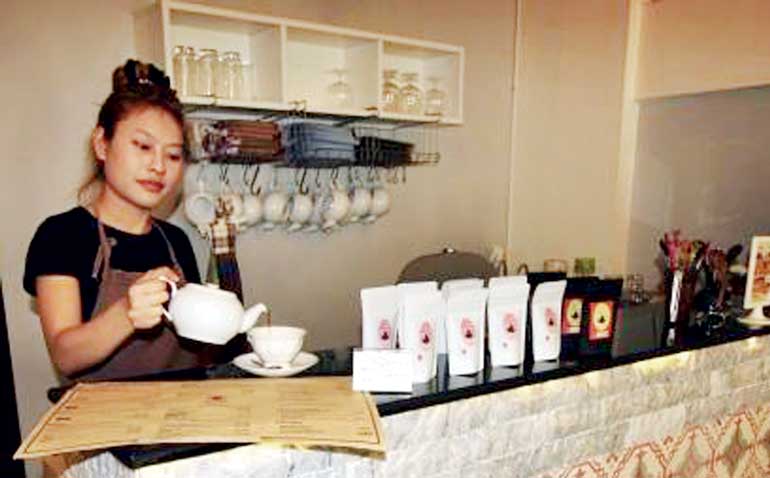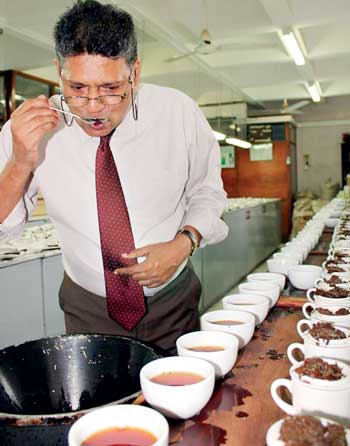Thursday Apr 25, 2024
Thursday Apr 25, 2024
Wednesday, 4 November 2015 00:00 - - {{hitsCtrl.values.hits}}

By Marwaan Macan-Markar
http://asia.nikkei.com: At the Ceylon Chamber of Commerce, in a semi-circular room reminiscent of an old university lecture hall, nearly 200 buyers sit at long tables listening to the commanding voice of the auctioneer. Standing behind a wooden platform at the front of the room, he calls out to one of them, a man to his right: “It is a superior tea, sir.”
The buyer apparently agrees. He accepts the leaves on offer, and the auctioneer bangs his wooden gavel to close the deal, moving on to the next lot with his rapid-fire pitch: “This is the best lot; please make a bid ...”
This scene plays out every Tuesday and Wednesday at the chamber, which uses the former colonial name for Sri Lanka. It is the Colombo Tea Auction, and for the last 132 years, it has brought buyers from all over the city to bid for one of Sri Lanka’s key exports, making it the oldest tea auction in the world. 
In another part of the city, in a long, well-lit room at the Sri Lanka Tea Board, Asoka Goonetilleke’s tongue is at work. The Deputy Director of the State agency takes quick sips from a variety of black teas, swirling each one in his mouth before spitting it into a silver container. For years, this quality test has helped Sri Lanka fetch premium prices for its brews – and underpinned its position as one of the world’s top tea exporters.
Back at the chamber of commerce, however, the auctioneer’s pitch seems to convey a tone of desperation, a reflection of the industry’s struggles with falling demand and political turbulence. At this auction, 11,000 lots of tea are on offer. Some seven million kilograms of tea change hands there each week.
Tepid demand
Lately, buyers have been lukewarm. Exporters to Russia and Iran, key destinations for Sri Lanka’s tea, say the weakening ruble and US trade and banking sanctions on Iran are hitting businesses hard. Demand has also been weak from Middle Eastern countries such as Syria, formerly a major consumer of Sri Lankan tea.
Export figures from the SLTB show that Sri Lankan tea exports to Russia fell from 15% of the total trade in 2012 to 13% by 2014. For Iran, the drop was more dramatic, down to 9.2% from 12.4% over the same period. The trend is thought to have continued this year. Total tea exports reached only 180.2 million kilograms for the first six months, a fall of seven million kilograms from the same period last year.
The situation is not helped by a thriving black market, an inadvertent byproduct of the U.S. sanctions. Middle Eastern tea traders are now peddling Sri Lankan teas to Iranian consumers through Dubai, an emerging tea trading hub.
“Ceylon tea has even been smuggled on camel caravans from Dubai or sometimes taken in boats across the water,” said Mansoor Akbarally, a Director of Akbar Brothers, Sri Lanka’s largest tea exporter. “So at the auction, technically, Iran didn’t leave, but the purchases were down, since the U.S. banking sanctions affected payments for orders.” A glut in the global supply of tea has compounded troubles for the island’s trade. The traditional black teas have been fetching around Rs. 400 ($2.83) per kilogram at recent auctions, down from the Rs. 475 per kilogram it was trading at in the first six months of last year. Some grades of teas are receiving even lower offers, at Rs. 350 per kilogram.
The fall in prices has eaten into the profits of the tea estates, which carpet the central hills of Sri Lanka from near sea level up to the chilly, mist-covered mountains 2,100 meters above. But it is these picturesque undulating hills that make Sri Lanka the most expensive place to grow tea, at a production cost of Rs. 430 per kilogram. Tea farming in Sri Lanka is labour-intensive; much of the work has to be done manually because the hills are not conducive to the use of machines.
Fashionable in China
Yields have also been dismal, in part because some estates are still harvesting from 150-year-old bushes that were planted when the crop was introduced under British colonial rule. Newcomers in the tea industry, such as Vietnam and especially Kenya, now the world’s biggest exporter of tea, have gained ground with better yields.
To some, the solution lies in exploring new markets for black teas, whose leaves are dried and rolled into different sizes in factories on the estates. Growing Chinese demand at the weekly tea auctions is a welcome relief. Exports to China in the first seven months of this year grew to 4.3 million kilograms, up from 2.9 million kilograms in the same period last year. Although that makes up only a small part of total exports, the potential is huge.
“The younger generation in China prefer our black teas as a way to be different from their parents who drink green tea, which they think is old-fashioned,” said Harshana Wayaman, Chairman of Enrich Tea and Food Exports, a leading buyer for the Chinese market. “The demand for the strong flavour of our teas grew in the last five years.”
Courting controversy
There are also more ambitious plans to take tea exports up the value chain to boost earnings, which, at $1.6 billion last year, totalled roughly 2% of gross domestic product.
The Tea Exporters Association is a leading advocate of a contentious plan aimed at pushing export earnings to $5.1 billion by importing foreign teas and blending them with pure Ceylon teas for re-export. If successful, the plan would transform Sri Lanka into a tea trading hub, and could also spawn a lucrative packaging and bagging industry.
The proposal has sparked fierce debate in the island’s clannish tea circles. The future of the tea industry is a hot issue for the government, which came to power this year, as it was for its predecessor. Resistance to tea blending from small tea growers, who farm more than 60% of the nearly 200,000 hectares under cultivation, is formidable. They fear that imported cheap teas will push them out of the supply chain. Most operate in the sun-drenched lower elevations, the home of stronger flavoured teas.
Purists, including trade veterans, are also stirring the pot. They argue that the distinct flavour and identity of Ceylon teas would be diluted if the plans for importing, blending and re-exporting are pushed through.
“This is a wild dream of irresponsible exporters; it will be the beginning of the end of our tea industry,” said Merill J. Fernando, founder of the family-owned company behind the Dilmah tea brand. “The answer is in innovative ways of marketing our tea.”
Fernando’s pure Ceylon teas appear on supermarket shelves in more than 100 countries, competing with global brands such as Twinings and Lipton, which are known for the variety of blends in their brews.
The new Government has stepped in with what is seen as a stopgap measure, urging the SLTB to buy Rs. 300 million worth of tea at the weekly auctions to create a stable but artificial market price. The main beneficiaries of this move will be the small tea producers, said Plantation Industries Minister Navin Dissanayake. But the intervention may come too late for some of the companies, which are saddled with large bank loans. According to an industry insider, many plantation companies are facing major problems and are up for sale.
Exporters also fear that State fiddling with the auctions – a well-oiled operation that continues to fetch better prices than comparable auctions in Kenya and India – could lead to a distorted market and a government left with stockpiles of tea.
The alternative is a longer-term solution built on a compromise between the defenders of the pure Ceylon brew and those eyeing global markets, trading local brands for international names. But neither side, it appears, is ready to sit down over a cup of tea and try to find the middle ground.